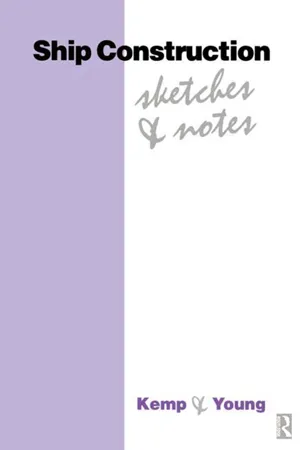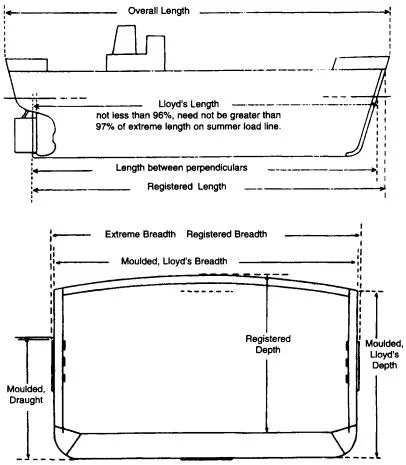
- 144 pages
- English
- ePUB (mobile friendly)
- Available on iOS & Android
eBook - ePub
Ship Construction Sketches and Notes
About this book
This classic book in the Kemp and Young series has been fully revised and updated by David J Eyres, author of the well-known Butterworth-Heinemann title "Ship Construction, " and will prove indispensable to the student reader. The contents cover, in numerous fully illustrated items, shipyard practices, principles of construction methods, the design and construction of the various component parts of the ship, and the overall arrangement of different types of merchant and passenger vessels.
Frequently asked questions
Yes, you can cancel anytime from the Subscription tab in your account settings on the Perlego website. Your subscription will stay active until the end of your current billing period. Learn how to cancel your subscription.
At the moment all of our mobile-responsive ePub books are available to download via the app. Most of our PDFs are also available to download and we're working on making the final remaining ones downloadable now. Learn more here.
Perlego offers two plans: Essential and Complete
- Essential is ideal for learners and professionals who enjoy exploring a wide range of subjects. Access the Essential Library with 800,000+ trusted titles and best-sellers across business, personal growth, and the humanities. Includes unlimited reading time and Standard Read Aloud voice.
- Complete: Perfect for advanced learners and researchers needing full, unrestricted access. Unlock 1.4M+ books across hundreds of subjects, including academic and specialized titles. The Complete Plan also includes advanced features like Premium Read Aloud and Research Assistant.
We are an online textbook subscription service, where you can get access to an entire online library for less than the price of a single book per month. With over 1 million books across 1000+ topics, we’ve got you covered! Learn more here.
Look out for the read-aloud symbol on your next book to see if you can listen to it. The read-aloud tool reads text aloud for you, highlighting the text as it is being read. You can pause it, speed it up and slow it down. Learn more here.
Yes! You can use the Perlego app on both iOS or Android devices to read anytime, anywhere — even offline. Perfect for commutes or when you’re on the go.
Please note we cannot support devices running on iOS 13 and Android 7 or earlier. Learn more about using the app.
Please note we cannot support devices running on iOS 13 and Android 7 or earlier. Learn more about using the app.
Yes, you can access Ship Construction Sketches and Notes by John F Kemp,Peter Young, D J Eyres in PDF and/or ePUB format, as well as other popular books in Physical Sciences & Geography. We have over one million books available in our catalogue for you to explore.
Information
Ship dimensions and terms
The ship's size and its form may be defined by a number of dimensions and terms.
LENGTH OVERALL is the length of the ship taken over all extremities.
LENGTH BETWEEN PERPENDICULARS is the length between the aft and forward perpendiculars measured along the summer load line.
AFTER PERPENDICULAR is a perpendicular drawn at the point where the aft side of the rudder post meets the summer load waterline. Where no rudder post is fitted it is taken as the centreline of the rudder stock.
FORWARD PERPENDICULAR is a perpendicular drawn at the point where the fore-side of the stem meets the summer load line.
MIDSHIPS is a point midway between the after and forward perpendiculars.
Where moulded dimensions are referred to these are taken to the inside of the plating on a ship with a metal hull.
MOULDED BEAM is measured at midships and is the maximum moulded breadth of the ship.
MOULDED DEPTH is measured at midships and is the depth from the base line to the underside of the deck at the ship's side.
MOULDED DRAUGHT is measured at midships and is the depth from the base line to the summer load line.
BASE LINE is a horizontal line drawn at the top of the keel plate.
LIGHT DISPLACEMENT is the weight of the hull, engines, spare parts, and with water in the boilers and condensers to working level.
LOAD DISPLACEMENT is the weight of the hull and everything on board when floating at the designed summer draught.
DEADWEIGHT CARRYING CAPACITY is the difference between the light and loaded displacements and is the weight of cargo, stores, ballast, fresh water, fuel oil, crew, passengers and effects on board.
STATUTORY FREEBOARD is the distance from the upper edge of the summer load line to the upper edge of the deck line.
RESERVE BUOYANCY is virtually the (available) watertight volume above the water-line.
SHEER may be defined as the rise of a ship's deck fore and aft. It adds buoyancy to the ends where it is most needed. A correction for non-standard sheer is applied when calculating the freeboard.
CAMBER OR ROUND OF BEAM is the curvature of the decks in the transverse direction, measured as the height of deck at the centreline above the height of deck at side. It helps to shed water from the deck and adds to its longitudinal strength.
FLARE is the outward curvature of the side shell above the waterline at the forward end of the ship. It increases buoyancy thus limiting sinkage of the bow into head seas, promotes dryness forward and provides a wider forecastle deck allowing the anchors to drop clear of the shell plating.
TUMBLEHOME is the inward curvature of the side shell above the waterline. Modern ships rarely have tumblehome.
RISE OF FLOOR is the rise of the bottom shell plating above the horizontal base line, measured at the ship's side. The object is to provide for the drainage of liquids to the ship's centreline.
Many of these terms and others, which are self explanatory, are illustrated (below).
DIMENSIONS

Classification
The principal maritime nations have Classification Societies whose primary function is to survey ships so as to assess the adequacy of their strength and construction, and for which purpose they publish rules. The British Classification Society is Lloyds Register of Shipping which classes most British shipping and, as it has world-wide connections with surveyors in the principal ports, a significant proportion of the world's tonnage. The scantlings (sizes) of the materials to be used, as well as certain items of equipment (anchors, cables and warps), can be obtained from Lloyds, ‘Rules and Regulations for the Classification of Ships’. This publication is amended and updated on a regular basis. The scantlings are based on the basic dimensions of the ship shown [on page 5] and defined below, detailed calculations of the still water bending moment and the section modulus of the particular item in association with other structural members.
| Length L | is the distance in metres on the summer load waterline from the foreside of the stem to the after side of the rudder post or to the centre of the rudder stock if there is no rudder post. L is not to be less than 96% of extreme length on summer load waterline and need not be more than 97% of that length. |
| Breadth B | is the greatest moulded breadth in metres. |
| Depth D | is measured in metres at the middle of length L from the top of the keel to the top of the deck beam at side on the uppermost continuous deck. With a rounded gunwale D is measured to the continuation of the moulded deck line. |
| Draught d | is the moulded draught in metres. |
A ship built to Lloyds highest class will be given this character,
+ 100 A 1
+ 100 A 1
+ indicates ‘built under survey’ which means the plans were submitted and approved, all steel was manufactured at an approved steelworks, and the construction was overseen by a surveyor.100A indicates the scantlings are in accordance with the Rules.1 indicates the equipment is in accordance with the Rules.
Ships built for a particular type of service have a Class Notation in addition to the above, e.g.l00A 1 Liquified Gas Carrier
If the ship's machinery is built and installed under Lloyds survey the character L.M.C. (Lloyd's Machinery Certificate) is assigned.
Where additional strengthening is fitted for navigation in ice an appropriate notation may be assigned. The notations fall into two categories: those for ‘first-year ice’ i.e. where waters ice up in winter only; and ‘multi-year ice’ i.e. Arctic and Antarctic waters. The latter includes the term ‘icebreaker’ in the class notation.
TERMS

In order to remain in class a classified ship is required to undergo surveys at regular intervals, as follows:
(a) Annual, (b) Intermediate (instead of 2nd or 3rd annual), (c) Special (every 5 years) or Continuous surveys where a maximum period of five years is allowed between the consecutive examination of each part. Special surveys increase in severity as the vessel gets older. Ships are to be examined in dry-dock at periods coinciding with the special and intermediate survey. An ‘in-water’ survey in lieu of the intermediate survey docking may be accepted.
All damage must be surveyed and repaired to the satisfaction of the Society's Surveyor.
A ship which is not classified will still have to reach a minimum standard of strength and have similar surveys. All [larger] ships trading internationally are required to have a ‘Ship Safety Construction Certificate’ issued by, or on behalf of, the government of the country of registration.
A large percentage of maritime insurance is effected at Lloyd's of London. Although the name is the same as that of the Classification Society there is no direct connection and the two should not be confused.
International shipping conventions
International shipping is regulated by conventions, the requirements of which are agreed at conferences convened by a United Nations agency, the International Maritime Organisation (IMO). These conventions come into force when a stipulated number of countries, that are members of IMO, become party to the convention by applying its requirements to their national shipping.
The following international conventions have a significant influence on ship design and construction.
Internat...
Table of contents
- Cover
- Half Title
- Title Page
- Copyright Page
- Table of Contents
- Preface
- Illustrations
- Ship dimensions and terms
- Index